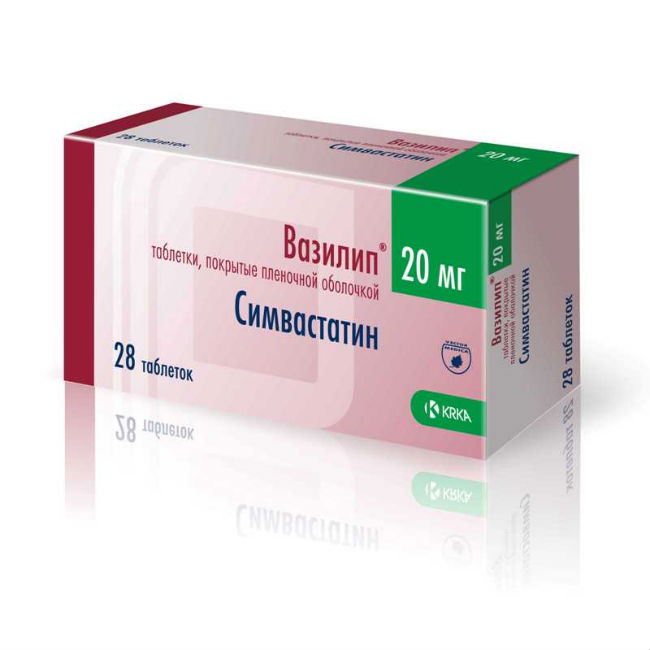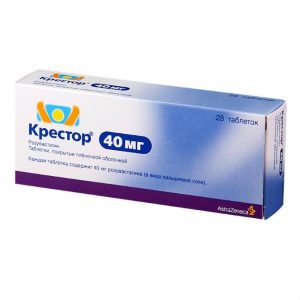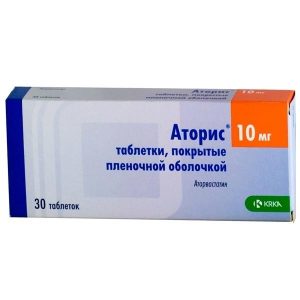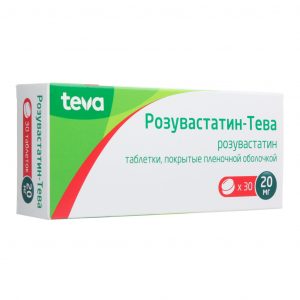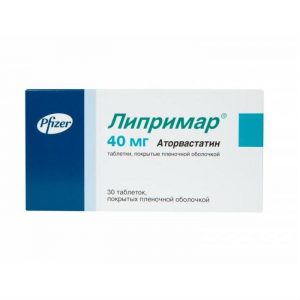Description
Packing
28 pcs
Pharmacological action of
The active substance of the drug Vazilip ® is simvastatin, the main effect of which is a decrease in the content of total cholesterol and LDL cholesterol in blood plasma. It is an inhibitor of 3-hydroxy-3-methyl-glutaryl-coenzyme A (HMG-CoA) reductase – an enzyme, catalyzing the conversion of HMG-CoA to mevalonic acid (early stage of cholesterol synthesis). Simvastatin reduces the concentration of total cholesterol, LDL cholesterol and triglycerides. Very low density lipoprotein (VLDL) cholesterol is also reduced, while HDL cholesterol is moderately increased. Reduces total cholesterol and LDL in cases of heterozygous familial and non-familial forms of hypercholesterolemia, with mixed hyperlipidemia, when elevated cholesterol is a risk factor. The drug lowers total cholesterol and LDL cholesterol in patients with coronary artery disease, reducing the risk of myocardial infarction and death for these patients.
simvastatin significantly reduces the content of apolipoprotein B, moderately increases the concentration of HDL cholesterol and reduces plasma concentrations of triglycerides (TG). As a result of these effects of simvastatin, the ratio of total cholesterol (OH) to HDL cholesterol (OH / HDL) and LDL cholesterol to HDL cholesterol (LDL / HDL) decreases.
The antiatherosclerotic effect of simvastatin is a consequence of the effect of the drug on the walls of blood vessels and blood components. Simvastatin alters the metabolism of macrophages, inhibiting the activation of macrophages and the destruction of atherosclerotic plaques. The drug inhibits the synthesis of isoprenoids, which are growth factors in the proliferation of smooth muscle cells of the inner lining of blood vessels. Under the influence of simvastatin, endothelium-dependent expansion of blood vessels improves.
The therapeutic effect occurs after 2 weeks, the maximum effect is observed after 4-6 weeks of treatment.
Indications
Hypercholesterolemia:
Primary hypercholesterolemia of types IIa and IIb, including polygenic hypercholesterolemia, heterozygous hereditary hypercholesterolemia and mixed hyperlipidemia. The drug is used as monotherapy in cases where diet and other treatment methods have been insufficient.
Cardiovascular prophylaxis:
Reduced cardiovascular mortality and morbidity in patients with clinical manifestations of atherosclerotic cardiovascular disease or diabetes with normal or elevated cholesterol and as an additional measure to correct other risk factors and cardioprotective therapy.
Contraindications
Hypersensitivity to simvastatin and other components of the drug.
Concomitant use of cytochrome P450 3A4 inhibitors (CYP3A4) (e.g. itraconazole, ketoconazole, HIV protease inhibitors, erythromycin, clarithromycin, telithromycin and nefazodone).
Pregnancy.
Lactation.
Age up to 18 years (efficacy and safety of use have not been studied).
Precautions: alcohol abuse before starting therapy, a history of liver disease, severe electrolyte imbalance, pronounced endocrine and metabolic disorders, arterial hypotension, severe acute infections (sepsis), myopathy, uncontrolled epilepsy, extensive surgery, trauma, lactase deficiency, galactosemia or glucose-galactose malabsorption syndrome (because the drug contains lactose), concomitant use with gemfibrozil, cyclosporine, nicotinic acid (more than 1 g / day), amiodarone, verapamil, diltiazem, fenofibrate, grapefruit juice.
Use during pregnancy and lactation
The drug is contraindicated in pregnancy. An increase in the incidence of congenital malformations in children whose mothers took simvastatin or another HMG-CoA reductase inhibitor has not been proven. When a pregnant woman is taking simvastatin, the fetus may decrease mevalonate levels, which is a precursor to cholesterol biosynthesis. The abolition of lipid-lowering drugs during pregnancy does not significantly affect the results of short-term risk associated with primary hypercholesterolemia.
Simvastatin should not be used in pregnant women, women planning a pregnancy, or if pregnancy is suspected. If pregnancy occurs during the treatment, the drug should be discontinued, and the woman should be warned of a possible danger to the fetus.
It is not known whether the drug is excreted in breast milk, therefore therapy with the drug Vasilip ® during breastfeeding is contraindicated.
Composition
1 tablet contains:
Active ingredient: simvastatin – 20 mg.
Excipients: lactose monohydrate starch pregelatinized butylhydroxyanisole citric acid anhydrous ascorbic acid starch corn MCC magnesium stearate.
Film sheath: hypromellose talc propylene glycol titanium dioxide.
Dosage and administration
Inside, once, in the evening.
The recommended dose of simvastatin varies from 5 to 80 mg once daily in the evening. The most common initial dose of Vazilip ® is 10 mg. Changes (selection) of the dose should be carried out at intervals of not less than 4 weeks. The maximum daily dose is 80 mg. This dose is recommended only for patients with severe hypercholesterolemia or a high risk of cardiovascular complications. The duration of the drug is determined by the attending physician individually.
Hypercholesterolemia
The patient must follow a standard hypocholesterol diet throughout the treatment period with Vasilip ®. The recommended starting dose is 10 mg. In order to more clearly reduce LDL cholesterol (by more than 45%), treatment can be started from 20 40 mg / day (once in the evening).
In patients with homozygous hereditary hypercholesterolemia, the recommended daily dose is 40 mg in the evening or 80 mg in 3 divided doses (20 mg in the morning, 20 mg in the afternoon and 40 mg in the evening), it is recommended that these patients use Vasilip ® in combination with other lipid-lowering therapy (for example, LDL apheresis) .
Cardiovascular prophylaxis
In patients with a high risk of coronary artery disease, hyperlipidemia, effective doses of Wazilip ® are 20 40 mg per day. Therefore, the recommended initial dose in such patients is 20 mg per day. Changes (selection) of the dose should be carried out at intervals of 4 weeks, if necessary, the dose can be increased to 40 mg per day. If the LDL content is less than 75 mg / dl (1.94 mmol / l), total cholesterol is less than 140 mg / dl (3.6 mmol / l), the dose should be reduced.
Concomitant therapy
The drug Vasilip ® is effective in monotherapy or in combination with bile acid sequestrants (for example, colestiramine and colestipol). In patients receiving treatment with cyclosporine, gemfibrozil, other fibrates or nicotinic acid (more than 1 g / day), the recommended initial dose is 5 mg, the maximum daily dose is 10 mg. Further dose increases in such situations are not recommended. In patients simultaneously receiving amiodarone or verapamil, daily doses of the drug Vazilip ® should not exceed 20 mg.
In elderly patients and patients with moderate renal failure, changes in the dosage of the drug are not required. In patients with severe renal failure (Cl creatinine <30 ml / min), the recommended dose of Vazilip ® should not exceed 10 mg per day. If it is necessary to increase the dose, careful monitoring of such patients is necessary. Side effects of From the gastrointestinal tract, liver: rarely – constipation, abdominal pain, flatulence, dyspepsia, nausea, vomiting, diarrhea, pancreatitis, hepatitis, jaundice, increased activity of hepatic transaminases, alkaline phosphatase, creatine phosphokinase (KFK). From the side of the central nervous system, peripheral nervous system and sensory organs: rarely – headache, paresthesia, dizziness, peripheral neuropathy, asthenia, insomnia, convulsions, blurred vision, impaired taste. From the musculoskeletal system: rarely – myopathy, rhabdomyolysis, myalgia, muscle weakness. Allergic and immunopathological reactions: advanced hypersensitivity syndrome (angioedema, lupus-like syndrome, polymyalgia rheumatism, dermatomyositis, vasculitis, thrombocytopenia, eosinophilia, increased erythrocyte sedimentation rate (ESR), arthritis, arthralgia, urticaria, photosensitivity, fever, flushing, shortness of breath and severe weakness). Dermatological reactions: rarely – skin rash, skin itching, alopecia. Other: rarely – anemia, palpitations, acute renal failure (due to rhabdomyolysis), decreased potency. Drug Interaction Pharmacodynamic Simultaneous administration of simvastatin with fibrates, nicotinic acid (more than 1 g / day) increases the risk of myopathy, including rhabdomyolysis (with simultaneous use with fenofibrate increased ). Concomitant use with gemfibrozil may lead to increased serum simvastatin concentrations. Pharmacokinetic Cytochrome CYP3A4 inhibitors (itraconazole, ketoconazole, erythromycin, clarithromycin, telithromycin, HIV protease inhibitors and nefazodone), involved in the metabolic conversion of simvamatostatin, Concomitant use with these drugs is contraindicated. With caution – when co-administered with less potent CYP3A4 inhibitors: cyclosporine, verapamil, and diltiazem. The daily dose of simvastatin, when taken with ciclosporin, should not exceed 10 mg. The daily dose of simvastatin when co-administered with amiodarone or verapamil should not exceed 20 and 40 mg – with co-administration of diltiazem unless the expected benefit clearly outweighs the potential risk of myopathy and rhabdomyolysis. Simvastatin at a dose of 20 40 mg / day in volunteers and patients with hypercholesterolemia potentiates the effects of coumarin anticoagulants (eg warfarin), in particular increased PV, MHO. Therefore, in patients taking coumarin anticoagulants, PV and MHO should be determined before starting simvastatin therapy, during the initial treatment period, with a change in simvastatin dose or with withdrawal. When stable PV and MHO are achieved, further monitoring should be performed at intervals recommended for patients receiving anticoagulation therapy. Simvastatin therapy does not cause changes in PV and the risk of bleeding in patients not taking anticoagulants. Grapefruit juice inhibits CYP3A4 activity. Simultaneous intake of a large amount of grapefruit juice (more than 1 liter per day) and simvastatin leads to a significant increase in the plasma concentration of simvastatin acid. Therefore, grapefruit juice should be avoided during simvastatin therapy. overdose Symptoms: There are several cases of simvastatin overdose. The maximum dose taken was 3.6 g. Treatment: in case of overdose symptomatic treatment is necessary to carry out general activities: monitoring and maintenance of vital functions, prevention of further absorption of the drug (gastric lavage, intake of activated charcoal or laxatives). Monitoring of liver function and CPF is recommended. There is no specific antidote. In the development of myopathy with rhabdomyolysis (a rare but severe side effect), immediately discontinue the drug, enter the patient with a diuretic and sodium bicarbonate (infusion). Rhabdomyolysis can cause hyperkalemia, which can be eliminated in / in the administration of calcium chloride and gluconate calcium, glucose infusion with insulin, use of potassium ion exchangers or, in severe cases, hemodialysis. Storage conditions Store at a temperature not exceeding 30 ° C. Keep out of the reach of children. Expiration 3 years. Deystvuyuschee substances Simvastatin pharmacy terms and conditions for prescription dosage form dosage form tablets KRKA d.d. Novo mesto AO, Slovenia
